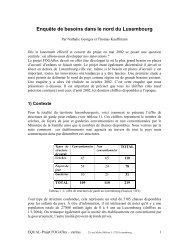Die Entwicklung integrierter familienunterstützender - Qualiflex.lu
Die Entwicklung integrierter familienunterstützender - Qualiflex.lu
Die Entwicklung integrierter familienunterstützender - Qualiflex.lu
Create successful ePaper yourself
Turn your PDF publications into a flip-book with our unique Google optimized e-Paper software.
England – 2. In-depth description of selected programmes and services<br />
2001) as well as the long-running Head Start and Perry Preschool programmes<br />
(Zigler and Styfco, 1994; Schweinhart et al, 1993). Moreover, the<br />
notions of ‘critical periods’ in child development and ‘brain plasticity’ developed<br />
in the neurosciences added to the impetus to focus on integrated<br />
early years’ service provision (Baird and Hall, 1985). Early intervention was<br />
found to be crucial for preventing developmental disorders and lessening<br />
the effects of disabilities. Finally, growing evidence on the importance of<br />
integrated communities led to a holistic, community development approach<br />
to early year’s intervention (Melhuish and Hall, 2007).<br />
One of the most salient needs that Sure Start aimed to address was child<br />
health. Previous to the implementation of Sure Start, there was general consensus<br />
that health services for children, social services, education, and the<br />
vo<strong>lu</strong>ntary sector were highly uncoordinated, which made diagnosis and<br />
treatment for children difficult (Melhuish and Hall, 2007). The situation was<br />
aggravated by a clear lack of communication and collaboration between<br />
professionals in these sectors. This was exacerbated by differences in training,<br />
culture, and concepts of confidentiality and evidence. Particularly problematic<br />
was the high number of children with ‘low severity’ disabilities, especially<br />
in low-income families (Burchardt, 2006). Cost-benefit analyses<br />
showed that ‘low severity’ disabilities, though less serious than disabilities<br />
such as cerebral palsy or autism, are far more frequent and consequently<br />
most costly for society. Behavioural disorders and general learning disorders<br />
are more difficult to identify but in the absence of effective intervention<br />
often lead to antisocial behaviour and crime (Rutter et al, 1976; Farrington,<br />
2003).<br />
2.2 Are services targeted or are certain services de<br />
facto used by certain groups only?<br />
The Sure Start programme makes provisions for childminders, Children’s<br />
Centres, Extended Schools, Maintained Nursery Schools, and Out of School<br />
Childcare (kids’ c<strong>lu</strong>bs). Each of these components focus on particular age<br />
groups, settings, or community needs. The programme aims to work across<br />
sectors and among various levels of government, encouraging cooperation<br />
between the private and independent sectors and local and national governments.<br />
Presently, the scope of Sure Start inc<strong>lu</strong>des roughly a third of all<br />
children in poverty in the UK. However, there is impetus to expand services<br />
by mainstreaming programmes to reach all children in poverty and by introducing<br />
additional rural and mini-Sure Start programmes. This section will<br />
explain the rationale for area-based interventions and inc<strong>lu</strong>de specific examples<br />
of targeted programmes and discuss their relationship to broader childcare<br />
policies.<br />
There remains disagreement over the relative merits of targeted and universal<br />
services among social policy research. In response, the designers of<br />
Every Child Matters attempted to combine both approaches, mixing the<br />
13



